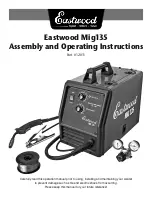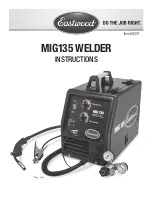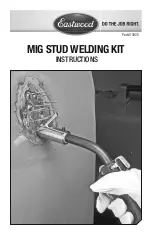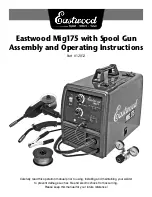
DC TIG Welding
Pulse TIG welding is when the current output (amperage) changes between high and low current. Electronics
within the welding machine create the pulse cycle. Welding is done during the high-amperage interval (this
high amperage is referred to as peak current). During the low amperage period, the arc is maintained but the
current output of the arc is reduced (this low amperage is referred to as base current). During pulse welding
the weld pool cools during the low amperage period. This allows a lower overall heat input into the base
metal. It allows for controlled heating and cooling periods during welding providing better control of heat
input, weld penetration, operator control and weld appearance.
There are 4 variables within the pulse cycle:
Peak Current - Base Current - Pulse Frequency - Pulse Width
Setting and manipulation of these variables will determine the nature of the weld current output and is at the
discretion of the operator.
Peak Current
is the main welding current (amps) set to melt the material being welded and works much the
same as setting maximum amperage values for regular DC TIG: as a guide use 30-40 amps for every 1mm of
material thickness.
Base Current
is the set level of background current (amps) which cools the weld puddle and effects overall
heat input. As a rule, use enough background current to reduce the weld pool to about half its normal size
while still keeping the weld pool fluid. As a guide start by setting the background amperage at 20 to 30
percent of peak amperage.
Pulse Frequency
is the control of the amount of times per second (Hz) that the welding current switches from
Peak Current to Base Current. DC Pulse TIG frequency generally ranges from 20 to 300 HZ depend-ing on the
job application. Control of the pulse frequency also determines the appearance of the weld.
Pulse Width
is the control of the on time of the peak amp. It is the percentage of time the peak amp is on
during one pulsing cycle. Example is with the Pulse Width set at 80 percent, the machine will spend 80% of
the pulse at peak amperage and 20% at the base amperage. Increasing the pulse width percentage adds
more heat to the job, while decreasing pulse width percentage reduces heat
DC Pulse Tig welding allows faster welding speeds with better control of the heat input to the job, reducing
the heat input minimising distortion and warping of the work and is of particular advantage in the welding
of thin stainless steel and carbon steel applications. The high pulse frequency capability of the advanced
inverter agitates the weld puddle and allows you to move quickly without transferring too much heat to the
surrounding metal. Pulsing also constricts and focuses the arc thus increasing arc stability, penetration and
travel speeds.
30
no pulse
high frequency
pulsing
no pulse
high frequency
pulsing
DC Pulse TIG Welding
Pulse TIG welding is when the current output (amperage) changes between high and low current.
Electronics within the welding machine create the pulse cycle. Welding is done during the high-amperage
interval (this high amperage is referred to as peak current). During the low amperage period, the arc is
maintained but the current output of the arc is reduced (this low amperage is referred to as base current).
During pulse welding the weld pool cools during the low amperage period. This allows a lower overall heat
input into the base metal. It allows for controlled heating and cooling periods during welding providing better
control of heat input, weld penetration, operator control and weld appearance.
There are 4 variables within the pulse cycle:
Peak Current - Base Current - Pulse Frequency - Pulse Width
Setting and manipulation of these variables will determine the nature of the weld current output and is at the
discretion of the operator.
Peak Current
is the main welding current (amps) set to melt the material being welded and works much the
same as setting maximum amperage values for regular DC TIG: as a guide use 30-40 amps for every 1mm
of material thickness.
Base Current
is the set level of background current (amps) which cools the weld puddle and effects overall
heat input. As a rule, use enough background current to reduce the weld pool to about half its normal size
while still keeping the weld pool fluid. As a guide start by setting the background amperage at 20 to 30
percent of peak amperage.
Pulse Frequency
is the control of the amount of times per second (Hz) that the welding current switches
from Peak Current to Base Current. DC Pulse TIG frequency generally ranges from 20 to 300 HZ depend-
ing on the job application. Control of the pulse frequency also determines the appearance of the weld.
Pulse Width
is the control of the on time of the peak amp. It is the percentage of time the peak amp is on
during one pulsing cycle. Example is with the Pulse Width set at 80 percent, the machine will spend 80% of
the pulse at peak amperage and 20% at the base amperage. Increasing the pulse width percentage adds
more heat to the job, while decreasing pulse width percentage reduces heat
peak amps
base amps
ON
OFF
Current
Time
DC Pulse Tig welding allows faster welding speeds with better control of the heat input to the job, reducing
the heat input minimising distortion and warping of the work and is of particular advantage in the welding
of thin stainless steel and carbon steel applications. The high pulse frequency capability of the advanced
inverter agitates the weld puddle and allows you to move quickly without transferring too much heat to the
surrounding metal. Pulsing also constricts and focuses the arc thus increasing arc stability, penetration and
travel speeds.
Razor
32OAC/DC
TIG-MMA
30
no pulse
high frequency
pulsing
no pulse
high frequency
pulsing
DC Pulse TIG Welding
Pulse TIG welding is when the current output (amperage) changes between high and low current.
Electronics within the welding machine create the pulse cycle. Welding is done during the high-amperage
interval (this high amperage is referred to as peak current). During the low amperage period, the arc is
maintained but the current output of the arc is reduced (this low amperage is referred to as base current).
During pulse welding the weld pool cools during the low amperage period. This allows a lower overall heat
input into the base metal. It allows for controlled heating and cooling periods during welding providing better
control of heat input, weld penetration, operator control and weld appearance.
There are 4 variables within the pulse cycle:
Peak Current - Base Current - Pulse Frequency - Pulse Width
Setting and manipulation of these variables will determine the nature of the weld current output and is at the
discretion of the operator.
Peak Current
is the main welding current (amps) set to melt the material being welded and works much the
same as setting maximum amperage values for regular DC TIG: as a guide use 30-40 amps for every 1mm
of material thickness.
Base Current
is the set level of background current (amps) which cools the weld puddle and effects overall
heat input. As a rule, use enough background current to reduce the weld pool to about half its normal size
while still keeping the weld pool fluid. As a guide start by setting the background amperage at 20 to 30
percent of peak amperage.
Pulse Frequency
is the control of the amount of times per second (Hz) that the welding current switches
from Peak Current to Base Current. DC Pulse TIG frequency generally ranges from 20 to 300 HZ depend-
ing on the job application. Control of the pulse frequency also determines the appearance of the weld.
Pulse Width
is the control of the on time of the peak amp. It is the percentage of time the peak amp is on
during one pulsing cycle. Example is with the Pulse Width set at 80 percent, the machine will spend 80% of
the pulse at peak amperage and 20% at the base amperage. Increasing the pulse width percentage adds
more heat to the job, while decreasing pulse width percentage reduces heat
peak amps
base amps
ON
OFF
Current
Time
DC Pulse Tig welding allows faster welding speeds with better control of the heat input to the job, reducing
the heat input minimising distortion and warping of the work and is of particular advantage in the welding
of thin stainless steel and carbon steel applications. The high pulse frequency capability of the advanced
inverter agitates the weld puddle and allows you to move quickly without transferring too much heat to the
surrounding metal. Pulsing also constricts and focuses the arc thus increasing arc stability, penetration and
travel speeds.
Razor
32OAC/DC
TIG-MMA
TIG WELDING GUIDE
26
Summary of Contents for RAZOR 320 AC/DC
Page 1: ...RAZOR 320 AC DC KUMJRRW320ACDC Operating Manual...
Page 2: ...2...
Page 45: ...NOTES 45...
Page 46: ...NOTES 46...
Page 47: ...NOTES 47...
















































